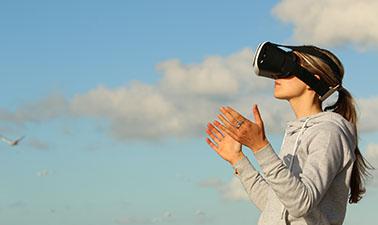- Level Foundation
- المدة
- الطبع بواسطة The University of California, San Diego
- Total students 10,133 enrolled
-
Offered by

عن
Virtual reality is changing the way we interact with the world. But how does it work, what hardware is involved, and how is software written for it?
In this course, part of the Virtual Reality Professional Certificate program, we will explore the foundations of user-friendly virtual reality app development for consumers, as well as enterprise solutions. Both hardware and software aspects will be discussed. You will learn to evaluate devices necessary for virtual reality applications, what their differences are, how you write interactive applications for virtual reality, and we will discuss the most frequent problems you are going to need to solve to write virtual reality software.
In this course, you will explore the basics of virtual reality software through copying and modifying JavaScript to explore tradeoffs in VR application design. Extensive programming experience is not required.
By the end of this course, you will understand what is important for successful virtual reality software and learn how to write simple virtual reality programs themselves with WebVR.
This course is taught by an instructor with almost two decades of experience in virtual reality who leads the Immersive Visualization Laboratory at UC San Diego.
What you will learn
- Types of virtual reality devices and their strengths and weaknesses
- How virtual reality applications differ from other interactive software programs
- What makes a virtual reality application successful
- What to avoid when writing virtual reality software
- Basic VR programming using WebVR
Skills you learn
Syllabus
- Week 1: VR definition and display systems
- Week 2: 3D Tracking and Input Devices
- Week 3: How to interact with the VR environment
- Week 4: How to move around in VR
- Week 5: 3D Menus and Text Input
- Week 6: VR app design
Auto Summary
Unlock the world of virtual reality with this foundational course designed for both budding developers and tech enthusiasts. This engaging course dives into the essentials of virtual reality (VR) technology, covering both hardware and software perspectives to equip you with the knowledge to create user-friendly VR applications for consumers and enterprises alike. Guided by an industry expert with nearly two decades of experience and leadership at UC San Diego's Immersive Visualization Laboratory, you'll explore the necessary devices for VR, their differences, and how to develop interactive VR applications. The course simplifies complex concepts, making it accessible even if you have limited programming experience by allowing you to learn through copying and modifying JavaScript. By the end of the course, you’ll not only understand the critical aspects of successful VR software but also gain practical skills to create simple VR programs using WebVR. This course is part of the Virtual Reality Professional Certificate program and is available through edX with a Starter subscription. Ideal for those at the foundation level in IT and Computer Science, this course offers a stepping stone into the immersive and rapidly evolving field of virtual reality. Join now and start your journey into the future of interaction technology!

Jurgen P. Schulze


